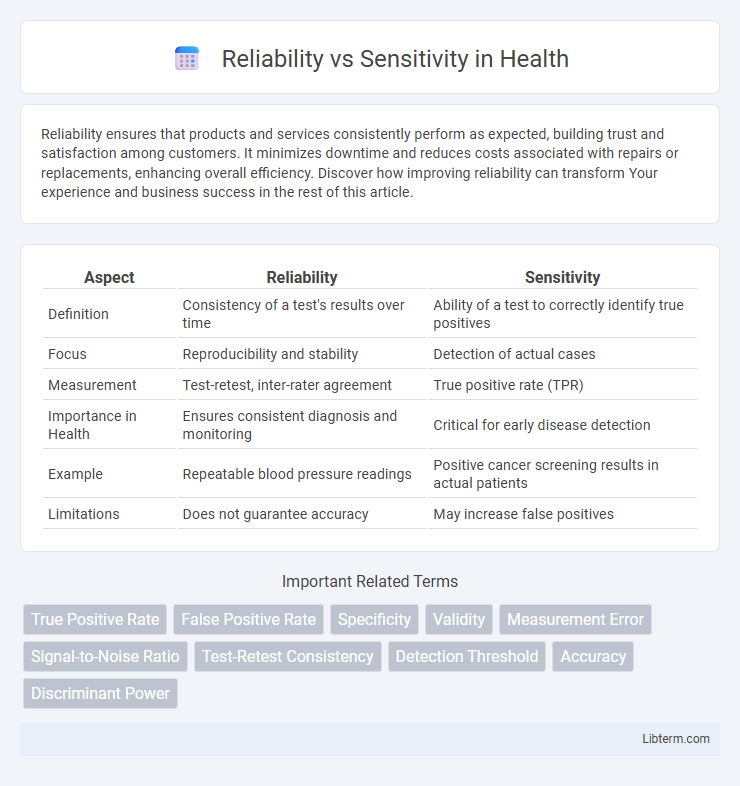Reliability ensures that products and services consistently perform as expected, building trust and satisfaction among customers. It minimizes downtime and reduces costs associated with repairs or replacements, enhancing overall efficiency. Discover how improving reliability can transform Your experience and business success in the rest of this article.
Table of Comparison
| Aspect | Reliability | Sensitivity |
|---|---|---|
| Definition | Consistency of a test's results over time | Ability of a test to correctly identify true positives |
| Focus | Reproducibility and stability | Detection of actual cases |
| Measurement | Test-retest, inter-rater agreement | True positive rate (TPR) |
| Importance in Health | Ensures consistent diagnosis and monitoring | Critical for early disease detection |
| Example | Repeatable blood pressure readings | Positive cancer screening results in actual patients |
| Limitations | Does not guarantee accuracy | May increase false positives |
Understanding Reliability and Sensitivity
Reliability refers to the consistency of a measurement or test in producing stable and repeatable results under identical conditions. Sensitivity measures the ability of a test to correctly identify true positives, effectively detecting the presence of a condition or characteristic. Understanding the balance between reliability and sensitivity is crucial in fields such as diagnostics and quality control to ensure accurate and dependable outcomes.
Defining Reliability in Measurement
Reliability in measurement refers to the consistency and stability of a test or instrument in producing the same results under consistent conditions. High reliability indicates that measurement errors are minimal, ensuring repeatability and dependability of data across multiple trials or assessments. This concept is critical in research and diagnostics to distinguish true effects from random variations.
What Is Sensitivity?
Sensitivity, also known as the true positive rate, measures a test's ability to correctly identify individuals with a condition or characteristic. It quantifies the proportion of actual positives that are accurately detected by the test, minimizing false negatives. High sensitivity is crucial in diagnostic settings where missing a positive case could lead to severe consequences.
Key Differences Between Reliability and Sensitivity
Reliability refers to the consistency of a measurement or test over repeated trials, ensuring stable and reproducible results, while sensitivity measures the ability to correctly identify true positives or detect minimal changes. Key differences include that reliability emphasizes repeatability and precision, whereas sensitivity focuses on detection accuracy and responsiveness to variations. High reliability does not guarantee high sensitivity, as a test can be consistently wrong, highlighting their distinct roles in evaluating measurement quality.
Applications of Reliability in Real-World Scenarios
Reliability in real-world applications ensures consistent performance and accuracy, crucial in fields like medical diagnostics, industrial quality control, and software development. High reliability minimizes errors and reduces the risk of failure, thereby enhancing user trust and operational efficiency. Unlike sensitivity, which measures the ability to detect true positives, reliability emphasizes repeatability and stability across various conditions and timeframes.
The Role of Sensitivity in Data Analysis
Sensitivity in data analysis measures a test's ability to correctly identify true positives, playing a crucial role in minimizing false negatives and ensuring accurate detection of relevant cases. High sensitivity is essential in fields like medical diagnostics and fraud detection, where overlooking critical instances can have severe consequences. Balancing sensitivity with reliability improves the overall effectiveness of analytical models by maintaining consistent and dependable results.
Factors Affecting Reliability
Factors affecting reliability include measurement consistency, tester competency, and environmental stability during testing. Instrument precision and standardized testing procedures significantly enhance the reliability of results. Variability in test conditions or participant responses tends to reduce reliability and distort data interpretation.
Factors Influencing Sensitivity
Sensitivity is influenced primarily by the quality and clarity of the measurement instrument, as well as the inherent variability within the sampled population. Higher sensitivity is achieved through precise calibration, reducing measurement error, and ensuring consistent testing conditions. Analytical techniques such as using refined thresholds or increasing sample size also significantly impact the detection capacity and responsiveness of a test or system.
Balancing Reliability and Sensitivity: Best Practices
Balancing reliability and sensitivity requires optimizing measurement tools to ensure consistent results while accurately detecting true positives. Implementing standardized protocols, regular calibration, and validation against benchmark datasets enhance both reliability and sensitivity in data analysis. Prioritizing cross-validation techniques and iterative testing supports minimizing false negatives and false positives, thereby achieving a robust balance for dependable outcomes.
Conclusion: Choosing the Right Metric
Choosing the right metric between reliability and sensitivity depends on the specific goals of the analysis or application. Reliability measures the consistency and stability of a test or instrument, ensuring reproducible results across different conditions, while sensitivity assesses the ability to correctly identify true positives or detect subtle changes. Prioritizing reliability is crucial when consistent measurement is essential, whereas sensitivity is key in contexts requiring accurate detection of rare or nuanced events.
Reliability Infographic

 libterm.com
libterm.com